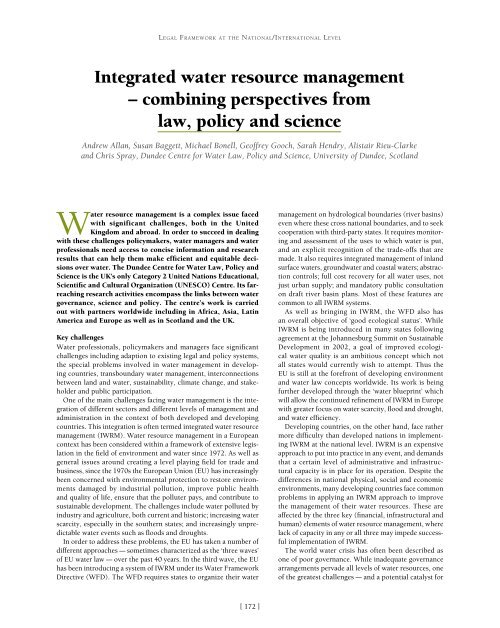222893e
222893e
222893e
You also want an ePaper? Increase the reach of your titles
YUMPU automatically turns print PDFs into web optimized ePapers that Google loves.
LEGAL FRAMEWORK AT THE NATIONAL/INTERNATIONAL LEVELIntegrated water resource management– combining perspectives fromlaw, policy and scienceAndrew Allan, Susan Baggett, Michael Bonell, Geoffrey Gooch, Sarah Hendry, Alistair Rieu-Clarkeand Chris Spray, Dundee Centre for Water Law, Policy and Science, University of Dundee, ScotlandWater resource management is a complex issue facedwith significant challenges, both in the UnitedKingdom and abroad. In order to succeed in dealingwith these challenges policymakers, water managers and waterprofessionals need access to concise information and researchresults that can help them make efficient and equitable decisionsover water. The Dundee Centre for Water Law, Policy andScience is the UK’s only Category 2 United Nations Educational,Scientific and Cultural Organization (UNESCO) Centre. Its farreachingresearch activities encompass the links between watergovernance, science and policy. The centre’s work is carriedout with partners worldwide including in Africa, Asia, LatinAmerica and Europe as well as in Scotland and the UK.Key challengesWater professionals, policymakers and managers face significantchallenges including adaption to existing legal and policy systems,the special problems involved in water management in developingcountries, transboundary water management, interconnectionsbetween land and water, sustainability, climate change, and stakeholderand public participation.One of the main challenges facing water management is the integrationof different sectors and different levels of management andadministration in the context of both developed and developingcountries. This integration is often termed integrated water resourcemanagement (IWRM). Water resource management in a Europeancontext has been considered within a framework of extensive legislationin the field of environment and water since 1972. As well asgeneral issues around creating a level playing field for trade andbusiness, since the 1970s the European Union (EU) has increasinglybeen concerned with environmental protection to restore environmentsdamaged by industrial pollution, improve public healthand quality of life, ensure that the polluter pays, and contribute tosustainable development. The challenges include water polluted byindustry and agriculture, both current and historic; increasing waterscarcity, especially in the southern states; and increasingly unpredictablewater events such as floods and droughts.In order to address these problems, the EU has taken a number ofdifferent approaches – sometimes characterized as the ‘three waves’of EU water law – over the past 40 years. In the third wave, the EUhas been introducing a system of IWRM under its Water FrameworkDirective (WFD). The WFD requires states to organize their watermanagement on hydrological boundaries (river basins)even where these cross national boundaries, and to seekcooperation with third-party states. It requires monitoringand assessment of the uses to which water is put,and an explicit recognition of the trade-offs that aremade. It also requires integrated management of inlandsurface waters, groundwater and coastal waters; abstractioncontrols; full cost recovery for all water uses, notjust urban supply; and mandatory public consultationon draft river basin plans. Most of these features arecommon to all IWRM systems.As well as bringing in IWRM, the WFD also hasan overall objective of ‘good ecological status’. WhileIWRM is being introduced in many states followingagreement at the Johannesburg Summit on SustainableDevelopment in 2002, a goal of improved ecologicalwater quality is an ambitious concept which notall states would currently wish to attempt. Thus theEU is still at the forefront of developing environmentand water law concepts worldwide. Its work is beingfurther developed through the ‘water blueprint’ whichwill allow the continued refinement of IWRM in Europewith greater focus on water scarcity, flood and drought,and water efficiency.Developing countries, on the other hand, face rathermore difficulty than developed nations in implementingIWRM at the national level. IWRM is an expensiveapproach to put into practice in any event, and demandsthat a certain level of administrative and infrastructuralcapacity is in place for its operation. Despite thedifferences in national physical, social and economicenvironments, many developing countries face commonproblems in applying an IWRM approach to improvethe management of their water resources. These areaffected by the three key (financial, infrastructural andhuman) elements of water resource management, wherelack of capacity in any or all three may impede successfulimplementation of IWRM.The world water crisis has often been described asone of poor governance. While inadequate governancearrangements pervade all levels of water resources, oneof the greatest challenges – and a potential catalyst for[ 172 ]


